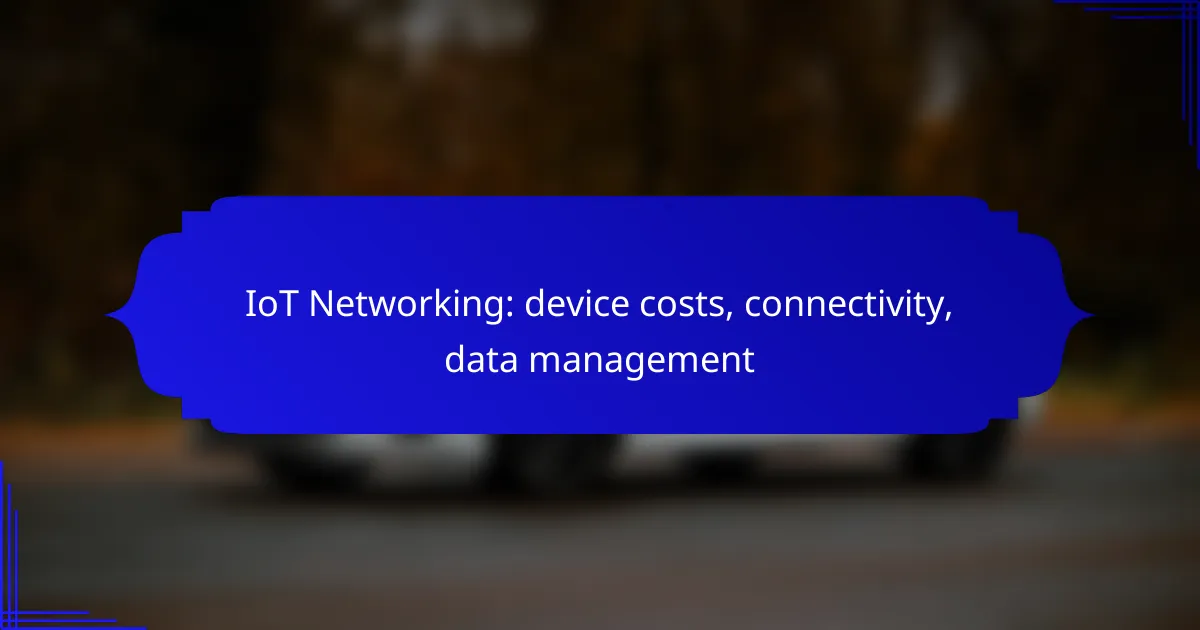The Internet of Things (IoT) encompasses a diverse range of devices, with costs varying significantly based on their type and functionality. Connectivity is achieved through various technologies and protocols, tailored to meet specific needs such as power efficiency or data speed. Effective data management is crucial for handling the extensive data generated by these devices, ensuring performance optimization and real-time insights.
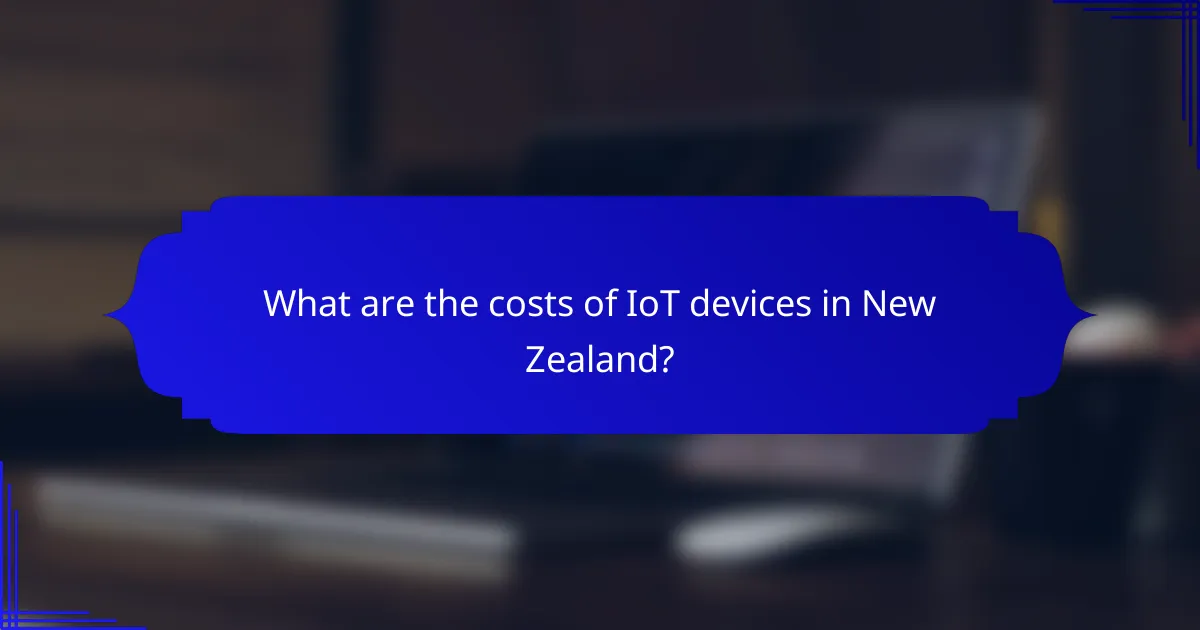
What are the costs of IoT devices in New Zealand?
The costs of IoT devices in New Zealand vary widely based on the type and functionality of the device. Consumer devices can range from affordable options to more expensive smart home systems, while industrial devices typically involve higher investments due to their complexity and durability.
Average price range for consumer IoT devices
Consumer IoT devices in New Zealand generally cost between NZD 50 and NZD 500. Basic smart home devices like smart bulbs and plugs are on the lower end, while advanced systems such as smart security cameras and home automation hubs can reach the higher end of this range.
Many consumers opt for packages or bundles that can offer better value, especially when integrating multiple devices into a single ecosystem.
Average price range for industrial IoT devices
Industrial IoT devices usually have a price range starting from NZD 500 and can exceed NZD 10,000 depending on the application. These devices are designed for durability and often include advanced features such as real-time monitoring and analytics capabilities.
Investments in industrial IoT solutions are typically justified by the potential for significant operational efficiencies and cost savings over time.
Factors influencing IoT device costs
Several factors influence the costs of IoT devices, including the technology used, the complexity of features, and the intended application. Devices with advanced sensors, connectivity options, and data processing capabilities tend to be more expensive.
Additionally, brand reputation and warranty offerings can also impact pricing, as well as the level of support and integration services provided by manufacturers.
Examples of popular IoT devices and their prices
Some popular consumer IoT devices include the Philips Hue smart bulb, which typically retails around NZD 100, and the Google Nest Hub, priced at approximately NZD 250. For industrial applications, devices like the Siemens S7-1200 PLC can cost around NZD 1,500, while advanced sensors for environmental monitoring can range from NZD 500 to NZD 5,000.
These examples illustrate the diversity in pricing and functionality across different categories of IoT devices, helping consumers and businesses make informed purchasing decisions.
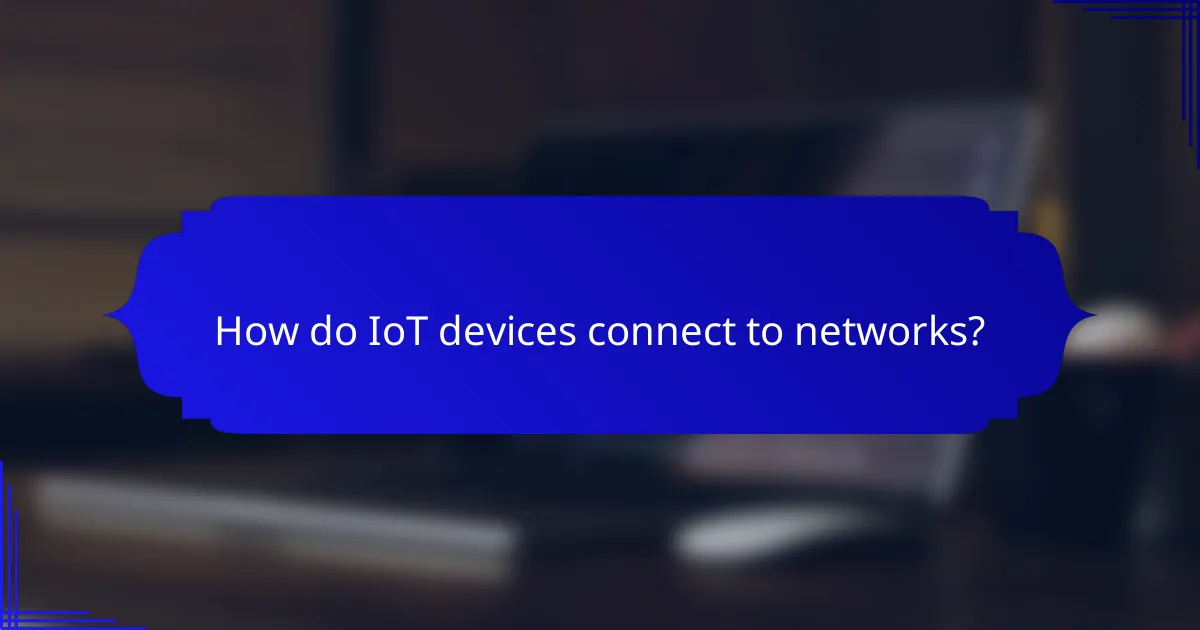
How do IoT devices connect to networks?
IoT devices connect to networks through various technologies that enable data transmission between devices and the internet. These connections can be established using protocols tailored for different use cases, such as low power consumption or high data throughput.
Common connectivity options for IoT devices
IoT devices typically use several connectivity options, including Wi-Fi, cellular networks, Bluetooth, Zigbee, and LPWAN (Low Power Wide Area Network). Each option has its strengths and weaknesses, making them suitable for different applications. For instance, Wi-Fi is great for high data rates in home automation, while LPWAN is ideal for long-range, low-power applications.
When selecting a connectivity option, consider factors like range, power consumption, data rate, and deployment environment. For example, cellular networks offer extensive coverage but may incur higher costs, whereas Bluetooth is suitable for short-range communication with minimal energy use.
Benefits of cellular vs. Wi-Fi connectivity
Cellular connectivity provides wide coverage and mobility, making it suitable for IoT devices deployed in remote areas or requiring constant movement. It supports various applications, from smart vehicles to agricultural sensors, and typically offers robust security features.
In contrast, Wi-Fi connectivity is often more cost-effective for devices within a limited range, such as smart home appliances. It allows for high-speed data transfer but may struggle with connectivity in large areas or when many devices are connected simultaneously.
Role of LPWAN in IoT connectivity
LPWAN plays a crucial role in IoT connectivity by enabling long-range communication with minimal power consumption. This technology is particularly beneficial for applications like smart agriculture, environmental monitoring, and asset tracking, where devices need to operate for extended periods on battery power.
LPWAN technologies, such as LoRa and Sigfox, allow devices to transmit small amounts of data over several kilometers, making them ideal for low-bandwidth applications. They are often more cost-effective than cellular options for devices that do not require constant connectivity or high data rates.
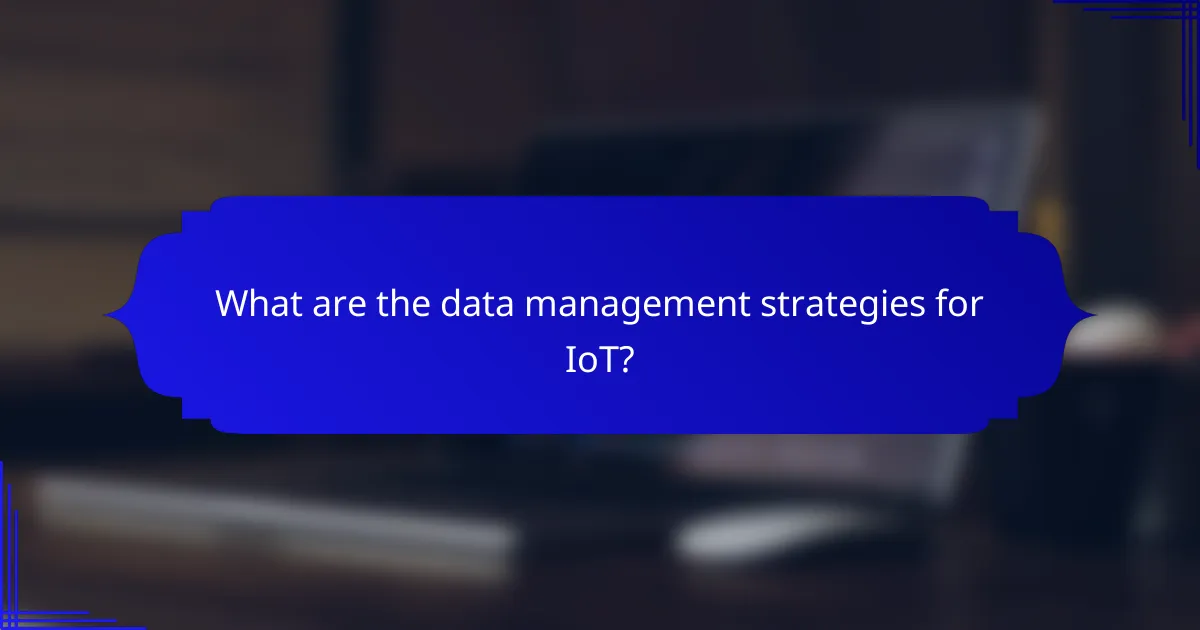
What are the data management strategies for IoT?
Data management strategies for IoT involve organizing, storing, processing, and securing the vast amounts of data generated by connected devices. Effective strategies are essential for optimizing performance, ensuring data integrity, and facilitating real-time insights.
Data storage solutions for IoT data
Data storage solutions for IoT typically include cloud storage, on-premises storage, and edge computing. Cloud storage offers scalability and accessibility, while on-premises solutions provide control and lower latency. Edge computing allows data to be processed closer to the source, reducing bandwidth usage and improving response times.
When selecting a storage solution, consider factors such as data volume, access speed, and security requirements. For instance, cloud services like AWS or Azure can handle large datasets but may incur ongoing costs, while edge devices may require upfront investment but offer faster data processing.
Data processing techniques for IoT
Data processing techniques for IoT include real-time processing, batch processing, and stream processing. Real-time processing is crucial for applications requiring immediate insights, such as smart home systems, while batch processing is suitable for less time-sensitive data analysis.
Stream processing allows continuous data flow analysis, making it ideal for monitoring applications. Choosing the right technique depends on the specific use case, data velocity, and the need for timely decision-making. For example, a smart city traffic management system may rely on real-time processing to adjust traffic signals dynamically.
Importance of data security in IoT
Data security in IoT is vital to protect sensitive information from breaches and unauthorized access. With numerous devices connected to the internet, each represents a potential vulnerability that can be exploited by cybercriminals. Implementing strong security measures is essential to safeguard data integrity and privacy.
Common security practices include using encryption, regular software updates, and secure authentication methods. For instance, implementing end-to-end encryption can help protect data transmitted between devices and the cloud. Organizations should also stay informed about relevant regulations, such as GDPR in Europe, to ensure compliance and protect user data.
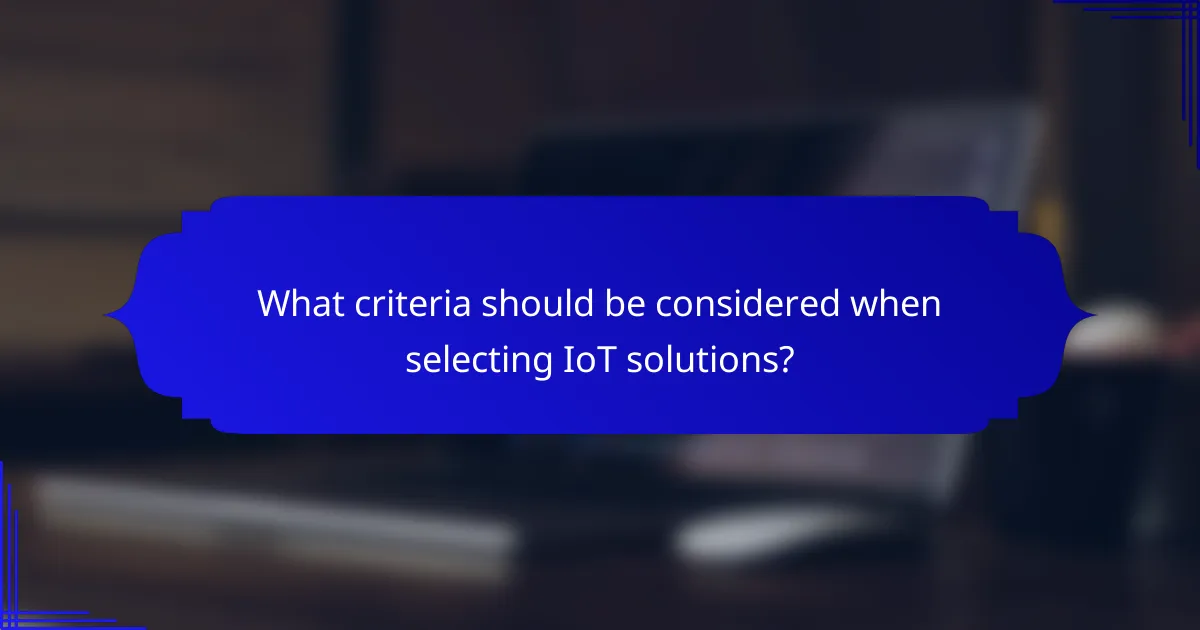
What criteria should be considered when selecting IoT solutions?
Selecting IoT solutions requires careful consideration of device costs, connectivity options, and data management capabilities. Key factors include the specific use case, scalability, security, and integration with existing systems.
Key factors in choosing IoT devices
When choosing IoT devices, consider their compatibility with your existing infrastructure and the specific requirements of your application. Look for devices that offer flexibility in deployment, such as those supporting various communication protocols like Wi-Fi, Bluetooth, or cellular.
Cost is another critical factor; devices can range from low-cost sensors to more expensive industrial-grade equipment. Evaluate the total cost of ownership, including maintenance and potential upgrades, to ensure long-term viability.
Evaluation criteria for IoT connectivity options
Evaluating IoT connectivity options involves assessing the coverage, bandwidth, and latency of different technologies. For instance, cellular networks may provide extensive coverage but can incur higher costs, while LPWAN (Low Power Wide Area Network) solutions offer lower costs with limited bandwidth suitable for small data packets.
Security features are essential; ensure that the connectivity option supports encryption and secure data transmission. Additionally, consider the scalability of the connectivity solution to accommodate future growth in device numbers and data traffic.
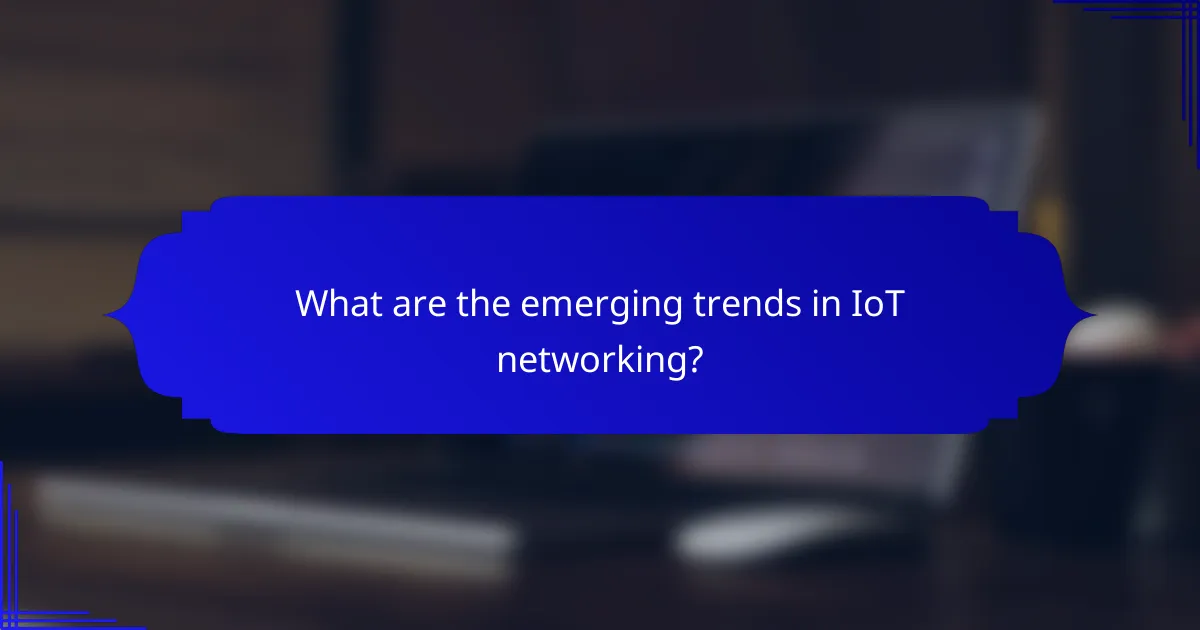
What are the emerging trends in IoT networking?
Emerging trends in IoT networking focus on enhanced connectivity, improved data management, and the integration of advanced technologies like 5G and edge computing. These developments are reshaping how devices communicate, process data, and interact with users and systems.
Impact of 5G on IoT connectivity
5G technology significantly enhances IoT connectivity by providing faster data transfer rates, lower latency, and greater device density. This means that IoT devices can communicate more efficiently, enabling real-time applications such as autonomous vehicles and smart city infrastructure.
The increased bandwidth of 5G allows for a larger number of devices to connect simultaneously without degradation in performance. This is crucial for industries relying on massive IoT deployments, such as agriculture and manufacturing, where thousands of sensors may operate in close proximity.
Future of edge computing in IoT
Edge computing is becoming essential in IoT as it allows data processing to occur closer to the source of data generation. This reduces latency and bandwidth usage, making it ideal for applications that require immediate response, such as healthcare monitoring and industrial automation.
By processing data at the edge, organizations can minimize the amount of data sent to centralized cloud servers, which can lead to cost savings and improved efficiency. For instance, smart cameras can analyze video feeds locally to detect anomalies, sending only relevant information to the cloud for further analysis.
Trends in IoT data management technologies
Data management technologies in IoT are evolving to handle the vast amounts of data generated by connected devices. Solutions like distributed databases and advanced analytics are becoming more prevalent, allowing businesses to derive actionable insights from their data streams.
Moreover, the adoption of artificial intelligence and machine learning in data management enables predictive analytics, helping organizations anticipate issues before they arise. Companies should consider integrating these technologies to enhance their IoT strategies and improve decision-making processes.
